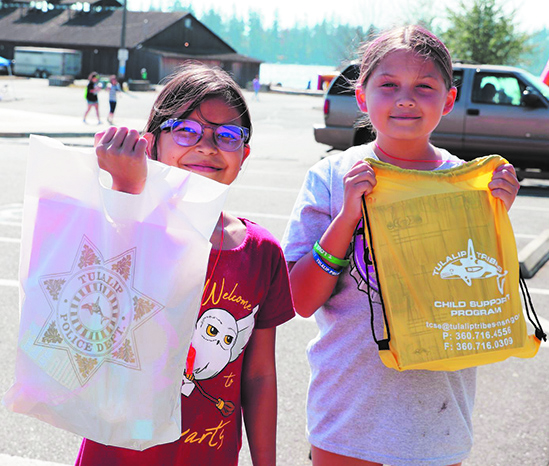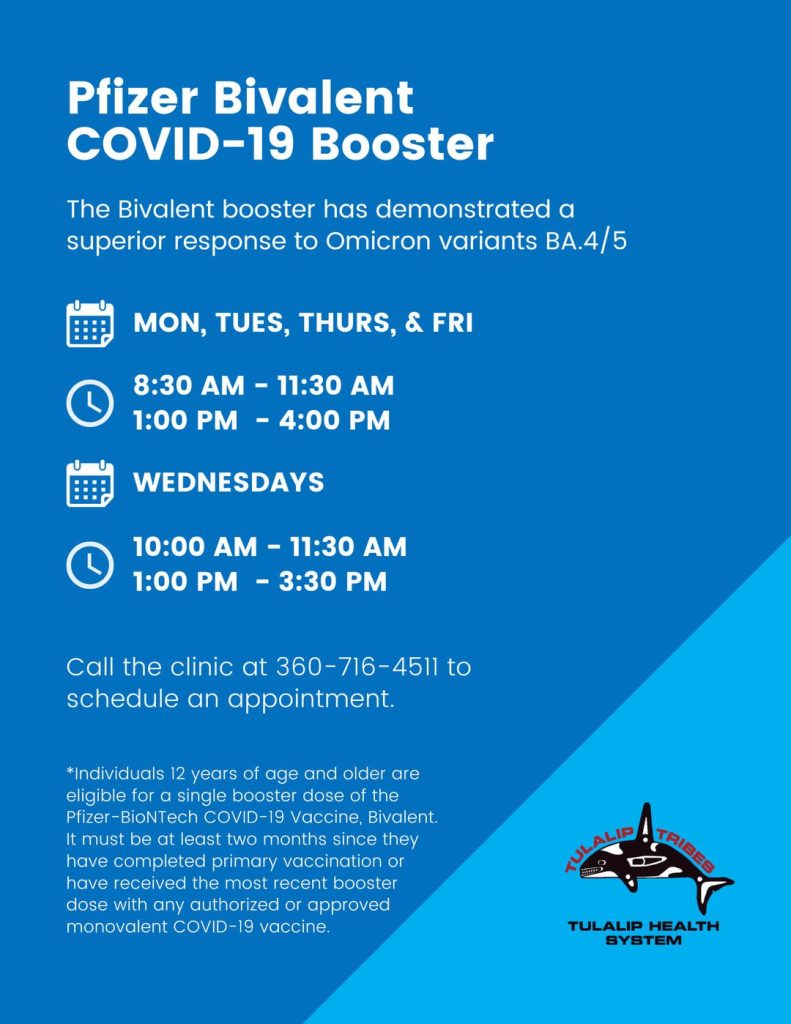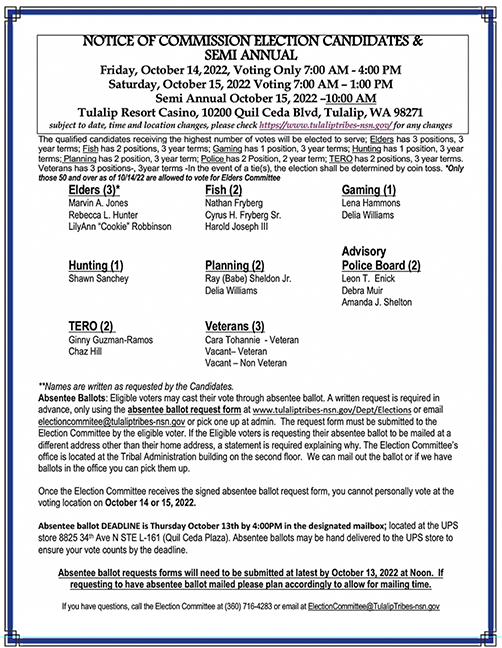
Pfizer Bivalent COVID-19 Booster available at Tulalip Health Clinic
September 10, 2022 syəcəb
Please use the following link to download the September 10, 2022 issue of the syəcəb
Hope Together, Heal Together: Tulalip Observes National Overdose Awareness Day
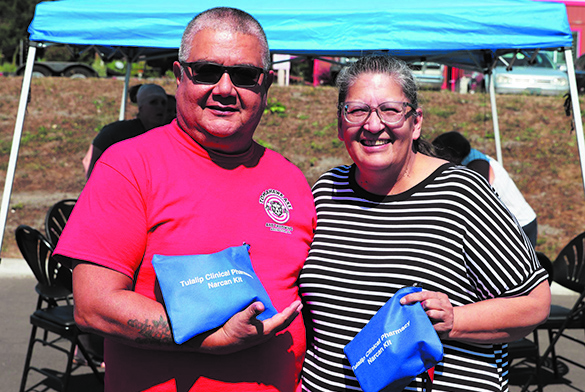
By Kalvin Valdillez, Tulalip News
“We lost so many of our people to overdose,” vocalized Tashena Hill, Tulalip Overdose Detection Mapping and Application Program (ODMAP) Outreach Specialist. “It’s important to commemorate them, and respect and honor their life that they lost to drug overdose and let their families and our community know that we love them.”
In 2021, there were an estimated 107,622 deaths nationwide due to drug overdose, according to provisional data gathered by the CDC’s National Center for Health Statistics. That is a 15% increase from 2020’s 93,655 recorded overdose deaths, which at the time was very alarming considering that itself was a 30% jump from the 71,000 reported overdose deaths in 2019. The numbers keep escalating as the years pass, breaking the hearts of family members throughout the country who hoped their loved ones would one day reach the road to recovery.
A look at the Snohomish County Medical Examiner’s Office Drug Overdose Dashboard shows that this year alone, there has been 188 drug overdose deaths in the county. 82 of those deaths involved opioids, 68 deaths involved fentanyl, and 67 deaths involved methamphetamine.
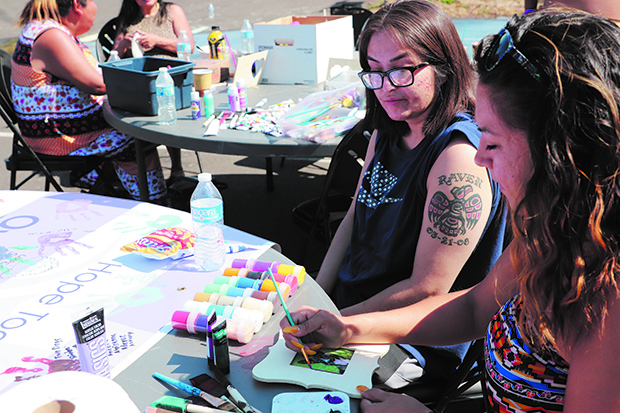
Multiple studies from the likes of the CDC and the Washington Post report that Indian Country has been hit by the opioid epidemic the hardest, claiming that from 2006-2014 Natives were 50% more likely to die from an opioid overdose than any other race in the country. Those reputable sources also released a disclaimer stating those statistics, though high, are still more than likely under reported due to a number of factors. Most misreporting stems from hospitals and coroners indicating the incorrect race on the death certificates of overdose victims.
And thanks to in-depth reporting from Tulalip News’ own Micheal Rios, he uncovered that there have been approximately 20 OD deaths on the Tulalip reservation since 2020.
“Natives have a higher rate of substance use disorder (SUD),” said Kali Joseph, the Tulalip ODMAP Project Coordinator. “The overdose rate amongst Native people have been on the rise since the year 2000. Even in Snohomish County, the rate of fentanyl overdoses is becoming epidemic levels and continuing to rise. It’s been really taking a toll on the communities. So many people have lost loved ones to overdose that it’s hard to find support, but when we hold community events like this, it’s a place to come together and it allows us to heal together.”
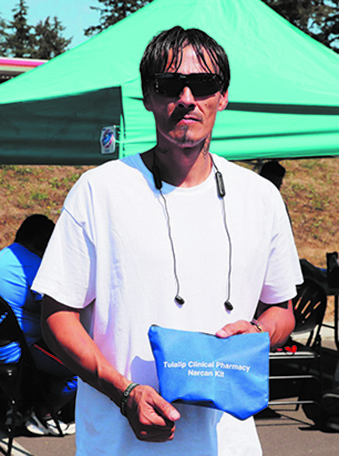
An important and healing gathering took place on the last day of August at the Tulalip Dining Hall. Hosted by Tulalip ODMAP and Tulalip Family Services, the event brought together the local recovery community and the Tulalip citizenship for National Overdose Awareness Day.
“Overdose Awareness Day is important to the community because it helps break the stigma,” stated Tulalip Family Services Chemical Dependency Professional, Donna Gray. “It helps the people who are struggling, it provides support and understanding to their family members. And hopefully, it puts enough compassion and understanding out there for someone who’s really struggling and will encourage them to reach out for help.”
Held every year on August 31, National Overdose Awareness Day presents an opportunity for communities to raise awareness about the opioid and fentanyl epidemic while also taking time to honor the loved ones who we lost to overdose.
Tribal member and recovering addict, Alisha Sua expressed, “I think there needs to be more events like this to help get information out there about this issue because there’s so many people dying from overdosing, so I think the more knowledge we have about it, the better off we’ll be.”
There were a number of fun activities at the event including a dunk tank, an arts and crafts station, as well as a raffle giveaway. Upon signing in, the participants received a Narcan kit to take home to utilize in case of an overdose emergency situation, which could ultimately help save a life.
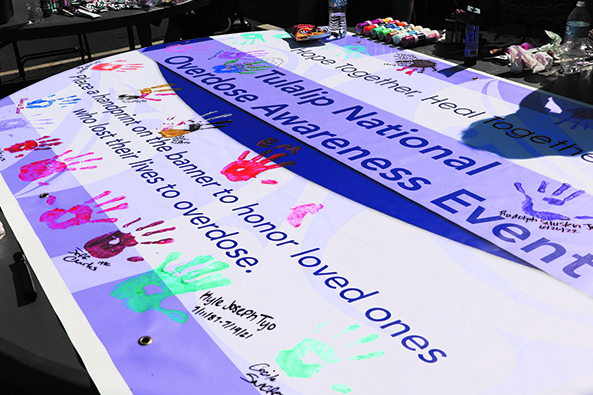
Said Kali, “Narcan is a medicine that is an opioid antagonist, so it reverses opioid overdoses. It can save lives and has saved many lives. We think that carrying a Narcan kit, even if you don’t struggle with SUD, is being a good relative because you can always be a bystander if an overdose incident happens. It can really save someone’s life, so we encourage people to get a Narcan kit. That’s why ODMAP has an incentive program for the Narcan, to get it out there and hopefully get it in every home in the community.”
Alisha added, “I like the awareness and the Narcan distributions happening out at the tribe, so more people are aware of possible ways to help people in a bad situation. We’re fortunate enough to be in a location that provides Narcan because I know that other states do not provide it. I like being able to get to it because you never know when you’re going to need it and it’s better to have it and not need it than need it and not have it.”
Those in attendance also got the chance to place a painted handprint on a large banner in memory of those whose lives were taken far too soon by addiction. Written next to the handprints were the names of each those individuals.
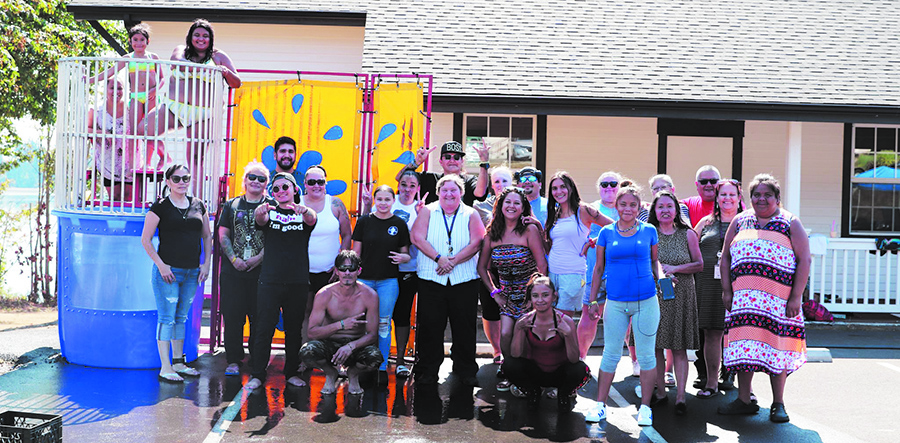
“We have community members who showed up today who have lost a loved one to overdose and they’ll put a handprint on our banner, it helps us acknowledge them,” Kali expressed. “I feel like it makes the folks who lost a loved one to overdose not feel alone and not feel like they’re the only ones who have experienced that loss. It goes back to the holistic health and how everything comes full circle, and that we as a community are taking action to heal from generational trauma. This is us being responsible for our loved ones who are struggling with SUD. If we work together collectively, we’ll be a strong united front. That’s why we say hope together, heal together.”
For more information, help, and additional resources please do not hesitate to reach out to Tulalip ODMAP at (360) 716-4773 or Tulalip Family Services at (360) 716-4400. And if you’re a Tulalip community member and would like to receive a free Narcan kit, please call or text (360) 722-2255 or visit www.tulaliptribalcourt-nsn.gov/ProgramsAndServices/ODMAP
BOD members place first bets at Sportsbook
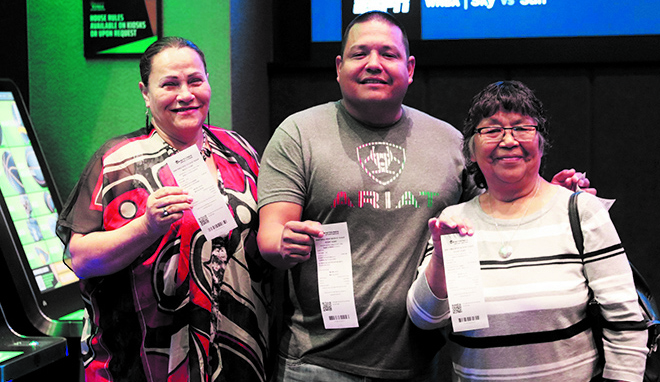
By Kalvin Valdillez, Tulalip News
The Tulalip Gaming Organization held the soft opening for their new sports betting venue, Sportsbook, on the afternoon of September 6. In partnership with Draft Kings, Tulalip is bringing Sportsbook to both of their gambling establishments at the Tulalip Resort Casino and the Quil Ceda Creek Casino.
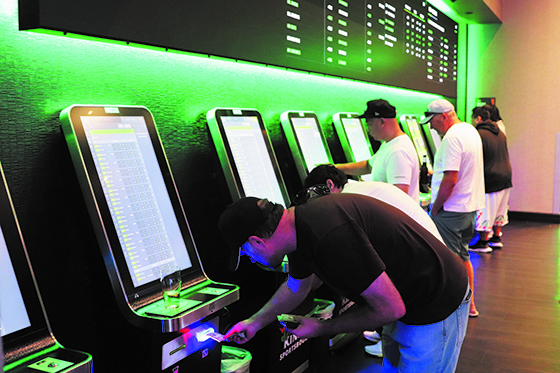
“Sports betting is new to Washington,” explained Sportsbook Supervisor Paola Hurtado. “I know there are several casinos that have opened but we are with Draft Kings. Draft Kings have different odds and there are different options of wagering. With us, you are able to bet on a lot of type of sports. Right now, we have MLB, NBA, WNBA, MLS, MMA, fights, and many more. Our guests are really excited for sports betting, now they don’t have to drive all the way out to Angels of the Wind or Snoqualmie, all they have to do is drive up the road.”
Sportsbook features a ginormous tv screen that can play multiple games, matches, and competitions in real time. Bettors can grab a seat in one of the venues comfy recliners and follow the results of their wagers live.
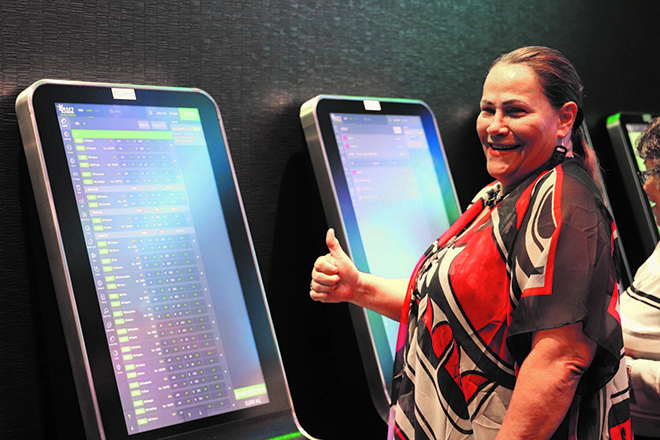
Placing the very first bets at Sportsbook were none other than Tulalip BOD members Hazen Shopbell and Marie Zackuse, as well as Chairwoman Teri Gobin.
Said Teri, “I bet on the Seahawks for $10, the Mariners for $100, and the Storm for $100. It’s really exciting that we are finally opening up our sports betting venue, both here (TRC) and at the Q. We have this big screen, it’s one of the largest in Washington State at this time, and we’re really excited. This has been a long time coming and it’s with one of the premier sports betting organizations in the United States. Our partnership with Draft Kings is really good and is what is really key to what is going to make this a success.”

The kiosks at Sportbook will be available 24/7 following the venue’s grand opening, which is tentatively scheduled for September 20. And according to Chairwoman Gobin there may or may not be some big stars in attendance to help celebrate the grand opening with the people.
“We were a little slow to get ours up and running, but we wanted to do it the Tulalip way and make it a grand event,” Teri expressed. “I’m so excited and can’t wait for everybody to try it out.”
For more info, please visit https://www.tulalipresortcasino.com/Sportsbook
Tulalip moms are stronger together
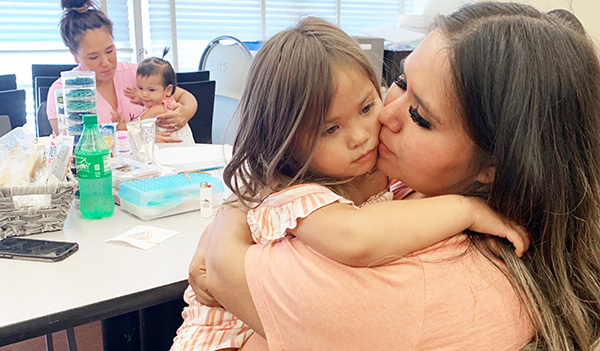
By Shaelyn Smead, Tulalip News
Every Tuesday for the past 10 years, Tulalip moms have been gathering within the Tulalip Mom’s Group; a group created by Family Haven as a safe place where mothers can have their kids play, and the moms can learn new skills, and utilize a variety of resources. For centuries, Native women have been known for their strength in adversity, their perseverance, and for being the heart of their community. However, even the most powerful women, need support too.
As many know to be true, mothers hold a sacred part of most family dynamics. We often call the land we live on and the world that surrounds us ‘Mother Earth’ and/or “Mother Nature”, Philosopher Mircea Eliade proposed a reflection of this name to be not so coincidental. Just like a mother, it is the first thing that we encounter when we enter this universe. Earth holds us just our mother does, nurtures us, and provides the very things that we need to survive. It’s a personification of the women that are life-giving and nurturing in the same ways that nature embodies.
The commonly used phrase “it takes a village to raise a child” has become a bit of an understatement over the years. With Native communities consistently facing issues like the cycles of addiction, generational abuse and trauma, disrupted families, lack of proper medical care, etc., raising a family has quite literally become one of the most difficult jobs. Native mothers are highly aware of the realities that Indigenous children face everyday. Outside of the community, the constant threat of colonial influence in public schooling systems, and the social influences that pressures assimilation in the lives of their children, Native mothers take on a plethora of responsibility in understanding what they must teach and protect their children from in order to preserve their sense of community and culture. Raising a child can be hard enough on its own, but raising a child in an environment that is consistently being disrupted can quickly become scary and extremely strenuous.
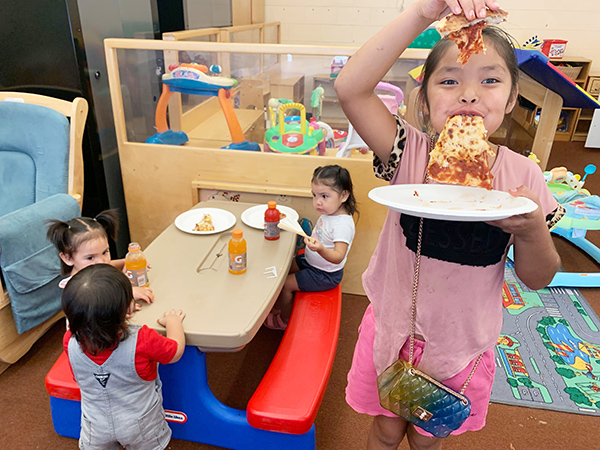
Youth and Family Support Coordinator Sasha Smith has been leading the Mom’s Group and spoke of the specific struggles that inherently effect Native communities, “With generational trauma, we have to look at how that also impacts parenting. With addiction, or lack of hygiene, or cases of abuse, it all plays a huge factor on how moms today are parenting and what they could still learn. If you were parented a certain way, you’re more than likely to parent your children the same way. With the group, moms learn that its okay to acknowledge the past, but also to know that there are things that they can change to give themselves and their children a bright future.”
The group provides many opportunities for mothers to learn organizational skills and parenting habits. The purpose is to teach skills that not only will help their families, but also make the mother a more well-rounded individual.
One major tool that the mothers utilize is the Baby Bucks Incentive Program. The program is designed for mothers to take personal responsibility for being a healthy mom and building a healthy family, and in doing so they earn ‘baby bucks.’ Every week during their meeting, each mom is given a paper with a list of motherly activities, such as taking their children to any needed appointments, exercising for 30 minutes, brushing their teeth day and night, reading with their children, eating together at the table, attending a community gathering, etc. Each activity accounts for a certain amount of ‘baby bucks’ that they earn, turn in, and is signed off by the group’s coordinator. And as they continue to earn and save more ‘baby bucks’ each week, they get to spend them on essential items at their Mom’s Group ‘store.’ The ‘store’ opens every few months and contains items such as kids’ toys, books, clothing, and bigger items like strollers, highchairs, etc., that is provided from funding through the charity table. So, in turn, the incentive program helps both the mother and her children with carrying out family skills, and provides items to help raise children.
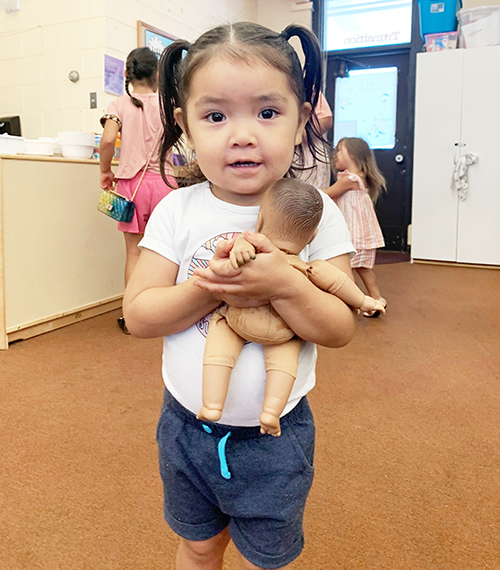
Every week, the moms have the opportunity to connect with other moms to ask questions and seek guidance. The group can request for certain lessons to be taught, adapting each week to the needs of the mothers. Some of the lessons are also gone over when the group partners up with other departments like beda?chelh, the Dental Clinic, the Health Clinic, and the Lushootseed department. These partnerships help bring awareness about the different resources that Tulalip offers to tribal parents and make the weekly lessons more specific and pertain to particular categories of Indigenous parenting.
The group also tries to integrate events outside of the group to give the moms and kids a different change in pace, and activities that are fun for families.
Outside of learning new skills, and access to more essential items, mothers are finding their community. Sometimes being a mom can feel so singular, it consumes you and you can easily feel overwhelmed. Being able to sit down and share a meal and having the support of other Native mothers that know exactly what you’re going through or just simply lending an ear can make all the difference. A place where they can share their grievances about their child’s behavioral problems, or family-related issues or anything else stressful in their life. Sometimes moms don’t need solutions or answers, they just need someone that will listen to them and sympathize with their struggles.
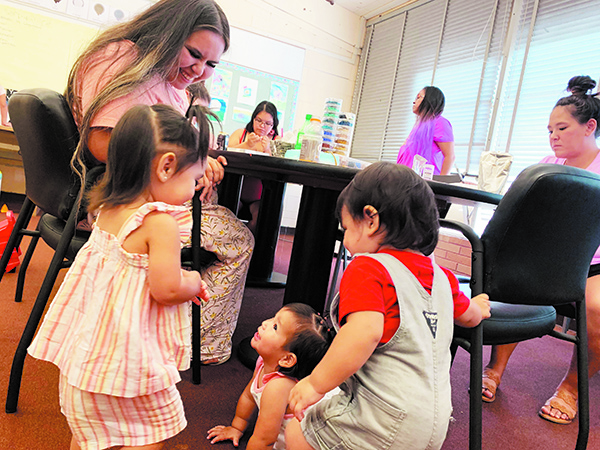
“The group fits the needs for women that are taking care of kids and need that extra support. It can be such a struggle being a parent, and we attract moms from all walks of life. We provide consistency and positive support that some might not be getting outside the group. We’re like a family of our own,” Sasha said.
Most of the women in the group have been attending since the creation of the group, and others since before they even gave birth to their children. It has become a space where women can just be themselves for a moment while their kids can run around and safely play with one another. Having a place that you can go every week and know that you have that sanctuary to just be.
Alayna Helland, Rosebud Sioux and Tulalip tribal member parent, has been attending Mom’s Group since March 2019. When she was finished with her 30-day treatment, she was 4 months pregnant, and in need of a positive environment and a new support system to help with her sobriety and all the challenges that comes with motherhood. Alayna said, “this group has made the biggest difference. I used to feel so isolated. Now I have friends that I can count on, that I know will check in on me, hold me accountable and keep me on the right path.”
With a few other moms in the group that are also tackling sobriety, she found a new sense of belonging in an atmosphere where she can be honest about her journey without judgement. Alayna also talked about how she looks forward to group every week, and the wealth of knowledge she has taken away, “I learned that by becoming a well-rounded person, I can become a more well-rounded parent” she said.
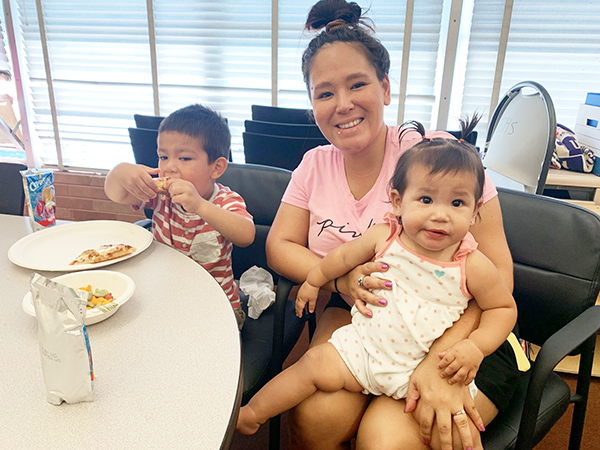
The Tulalip Mom’s Group is reigniting traditional support systems by connecting Tulalip moms with other Tulalip moms, aunties, cousins, sisters and grandmothers. The group isn’t designed to have a formal structure, but rather bring forth the love, teachings, skills, and care that come with child-rearing within tribal communities. It teaches every day tasks that a mother should know to take care of the basic needs of their children, with an additional influence of the culture of our people. The group is designed not to teach you how to be just an effective mother, but how to be an affective Indigenous mother. Knowing the difference is what makes the Mom’s Group so special. Teaching the mothers skills like beading, weaving, and language is just a handful of the Native artistry that can be learned and taught to their children.
In a recent article written by the International Union for Conservation of Nature, Indigenous Maya leader and activist, Dr. Anita F. Tzec spoke about Indigenous mothers and said, “we are the sacred promise and covenant with our future generations as we pass knowledge and techniques between grandmothers, mothers, and daughters.”
The Tulalip Mom’s Group is continuing to uplift each other and future generations. All mothers, aunties, cousins, sisters, and grandmothers that are raising Tulalip children are invited attend and join this free group at any time. Sasha is transitioning out as the group’s leadership, and integrating Kylee Sohappy into the role. If you would like to join, or have any questions about the group, please contact Kylee at 360-716-4402.
Tulalip Days returns
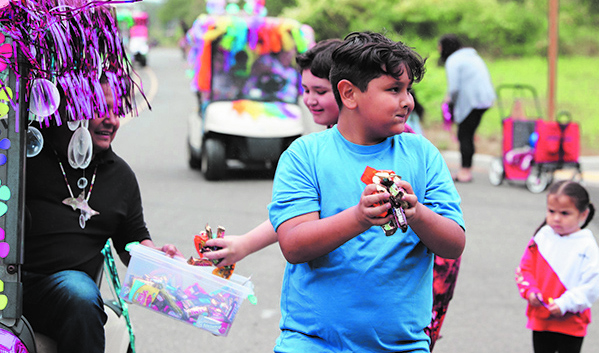
By Kalvin Valdillez, Tulalip News
A local tradition made a comeback on the morning of September 3. Once held annually, the Tulalip Days festival was often fondly recalled by the older generations of the community over the last eighteen or so years. In an effort to recreate all the fun that Tulalip Days brought to the youth and people of the reservation, the tribe decided to bring back the celebration this year during Labor Day weekend.
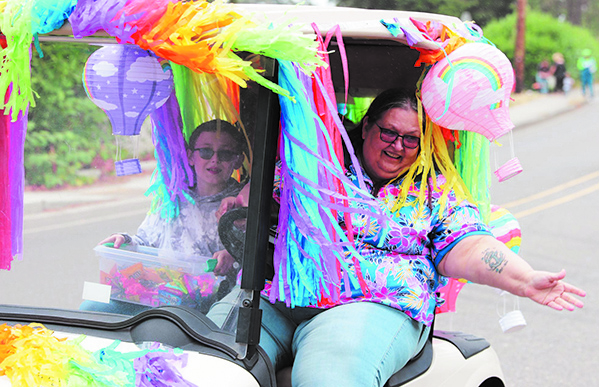
“This is kind of the kick-off,” said Malory Simpson, Tulalip Events Coordinator. “Shelly [Lacy] (Tulalip Tribes CEO) asked us to bring it back and it was awesome. It was really good to see everybody who showed up. We plan on being more proactive and have more activities next year, and continue with the parade, bring on a basketball or softball tournament, a powwow. The opportunities are open and I’m excited to see how planning goes next year.”
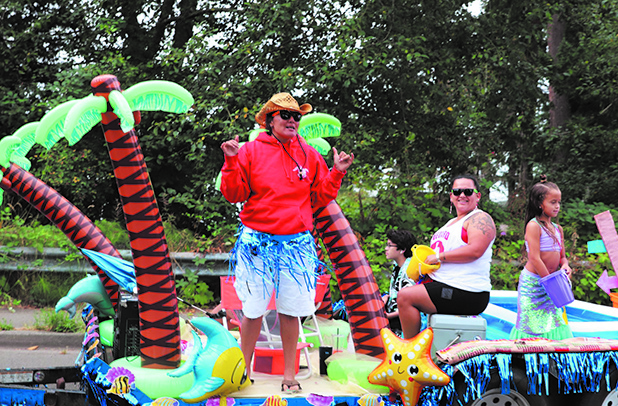
Back in the day, Tulalip Days was probably most famous for their parade. And of course, the parade was a major highlight of this year’s festivities as well. Community members met at the Betty J. Taylor Early Learning Academy Saturday morning to decorate their vehicles for the parade.
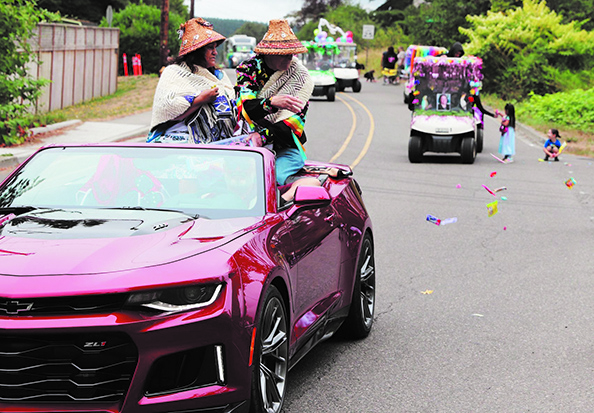
Over fifty fun-themed floats made the trek along Totem Beach Road to the Don Hatch Youth Center campus. The Tulalip Honor Guard led the way, followed by several Tulalip Police Department and Tulalip Bay Fire Department vehicles. Immediately behind the emergency response vehicles was a groovy golf cart, and in the passenger-seat sat Tulalip Chairwoman Teri Gobin, who played a few riffs on a six-string while wearing a Bret Michaels-esque rocker’s wig.
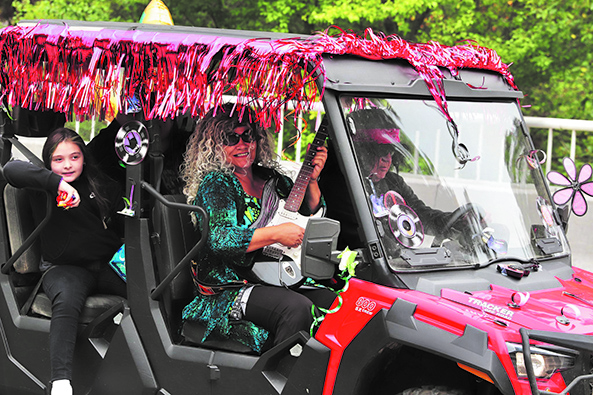
One by one, golf carts, trucks, trailers, four-wheelers, and even the famous blue bus, passed by the community of onlookers who lined both sides of Totem Beach Road. Candy was thrown out by the handful to the kids, who happily and hurriedly gathered the treats off the street.
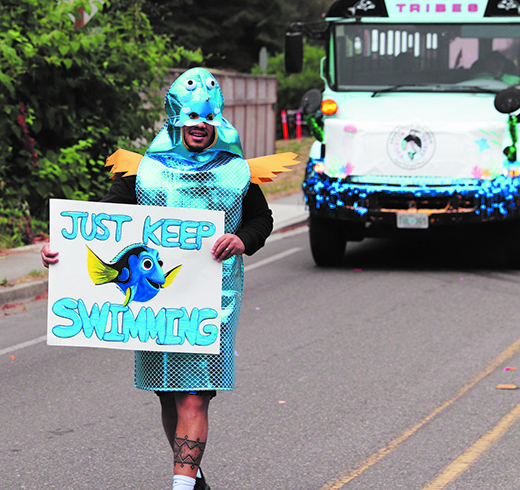
Among the many creatively decorated floats were themes ranging from Jurassic Park, Mario Bros, tropical beach, the 90’s, Under the Sea, Hawaii, Candyland, comic books, and the jungle. The Tulalip Heritage Hawks football team also made an appearance in the parade, as did numerous local tribal motorcyclists.
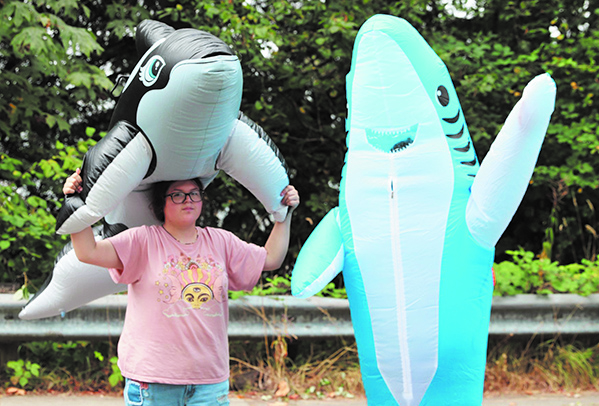
“I had tons of fun,” said young Kalese Pablo. “I was actually in the parade, on the beach float. I was a shark and I handed out candy to all the little kids around our community. I haven’t seen a lot of my friends and family because it’s summer and I’ve been on a lot of trips. So, it was really great to get back together with them and have fun.”
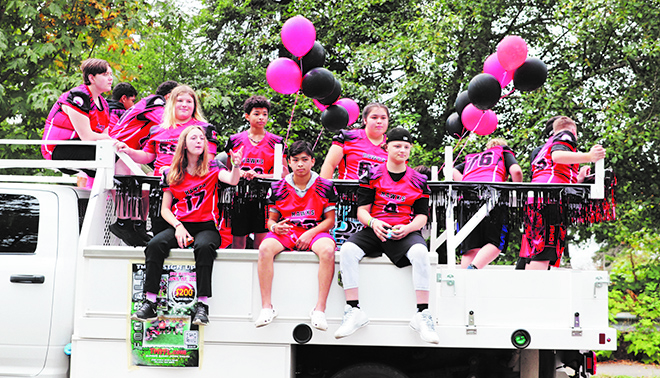
Tulalip Heritage Hawks athlete Miko Sanchez was also in the parade, and he stated, “It was amazing. I felt like it really lifted the spirits of the community on the reservation. I was in the parade with my teammates, and I thought that it was a great team building moment.”
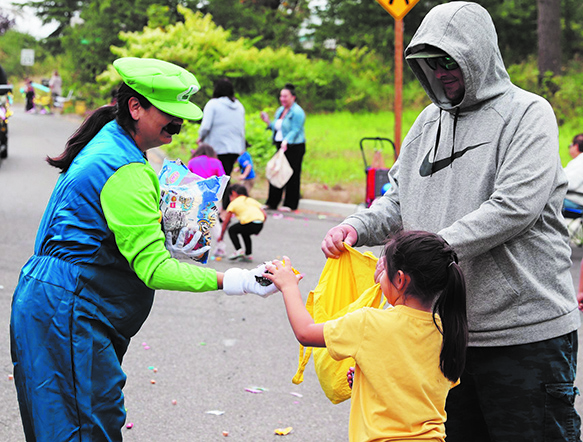
Following the parade, the people were distributed food tickets to use at the vendor of their choosing including Ryan’s REZ-ipes, Jared’s CORNer, and TEE PEE Creepers. Tribal vendors were also in attendance selling tie-dye t-shirts, salves, balms, hats, jewelry, artwork, and medicine to the people. Prizes were awarded to a number of tribal government departments that participated in the parade for their creatively decorated floats. And the one and only DJ Monie provided good vibes and tunes throughout the entire event.
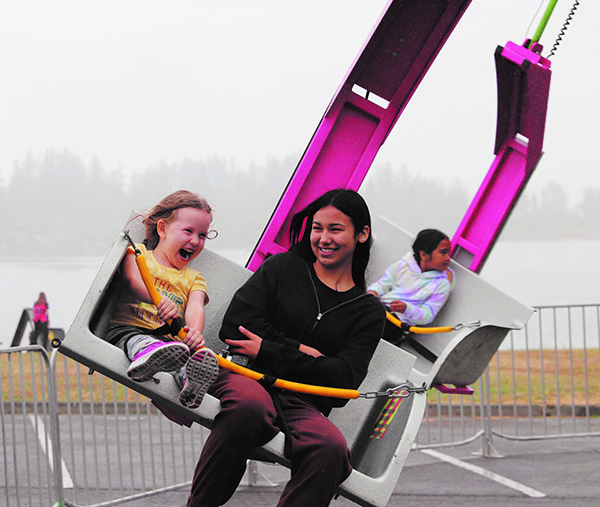
There were plenty of games and attractions to keep the youth occupied during the five-hour event including, bungee trampolines, video game stations, a giant slide, inflatable bumper balls, bouncy houses, laser tag, and a ballistic swing carnival ride.
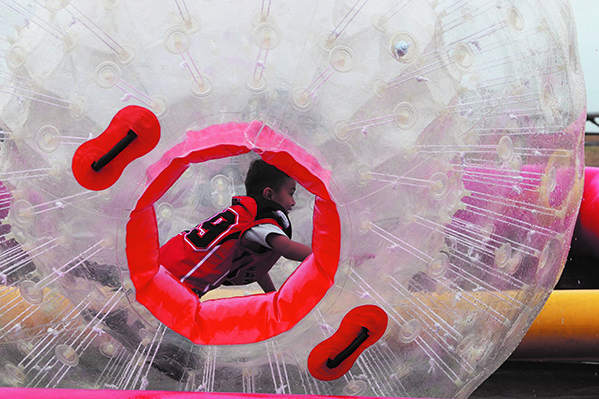
“It was a good day,” reflected Delia Williams. “My kids were excited to go to the parade and we got a lot of candy. When we got here, we instantly went for the ride, the swings. My kids got to ride with their cousins, and I rode by myself, because I’m you know a big kid. I love Tulalip Days. I think it’s good for the kids. I think we should see more of it and even more attractions for the kids, like a full-on carnival.”
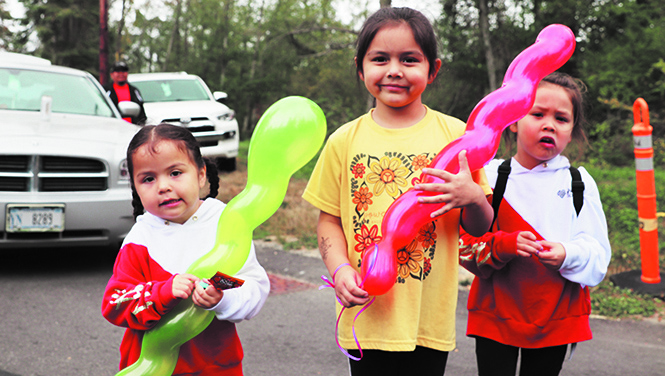
Although there was a little drizzle at the beginning of the event, Tulalip Days was full of bright and beaming smiles as the people enjoyed sharing time together with their friends and family, while also proudly showcasing their Tulalip pride.
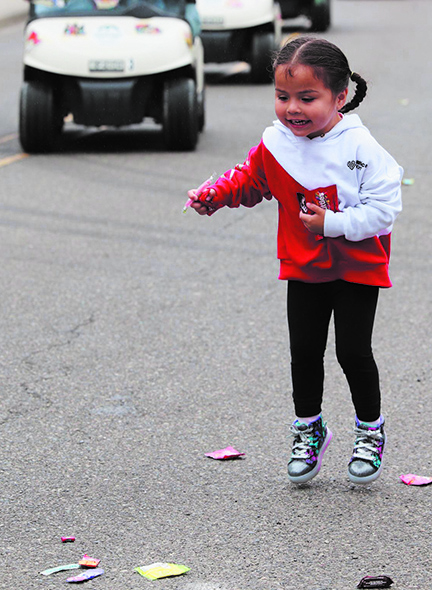
“I’m glad the events staff and the tribe are doing this for the kids and community,” said Tribal member Marlin Fryberg Jr. “There was a little rain, not too much. But it was good to see everyone’s faces again, especially with what we’ve been through the past couple of years. Food was good. We’re all in line for free food, I thank the council for that. The parade was fun, I took my daughter, wife, and mother in-law and we sat alongside and got all the candy, probably don’t have to shop for Halloween now. It was good to witness all the excitement of the young kids in the parade.”
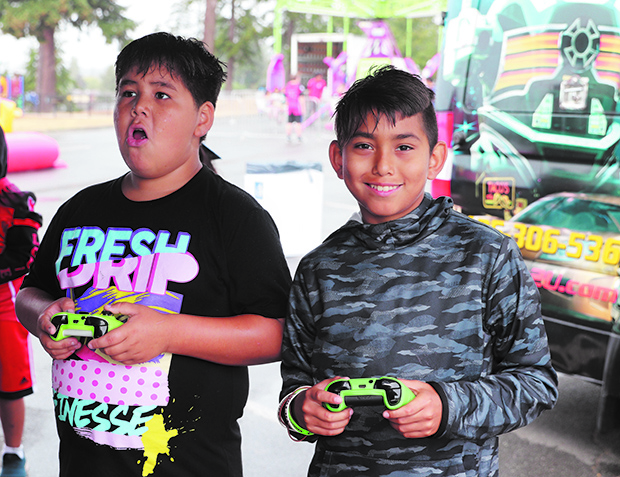
He continued, “Hopefully we can incorporate Tulalip Days with the canoe races in the future, kind of like we did when I was a kid. We had all the events in one weekend and that was always fun. But today felt good and hopefully we can continue this. We have a good turnout here, but it could be bigger. Maybe more advertisement next year, just continue it so it gets bigger and bigger because that’s what our old people want to see.”
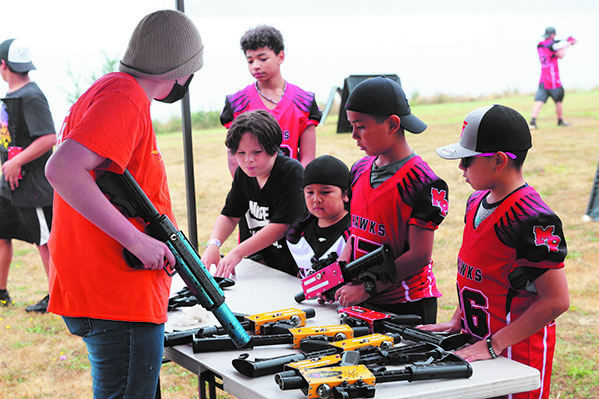
After the excitement of the day, Shelly Lacy reassured the community that Tulalip Days is here to stay. In a Facebook post she said, “Thank you to all the staff and committee who helped plan and make today possible. Thank you to all the community who came out today with parade entries, to watch the parade and to enjoy the activities. It was great to see everyone. It also felt good to come together as a community for fun times. This will be an annual event that will continue to grow.”
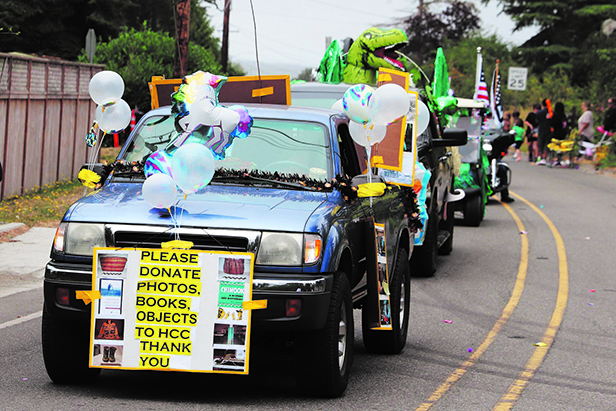
To commemorate Tulalip Days, a coastal jam was held following the festival. Tulalip tribal members and community members, and also drummers and singers from other nearby tribes, gathered at the Greg Williams Court to celebrate an evening of culture and bring Tulalip Days to a close in traditional fashion.
It’s huckleberry harvest time!
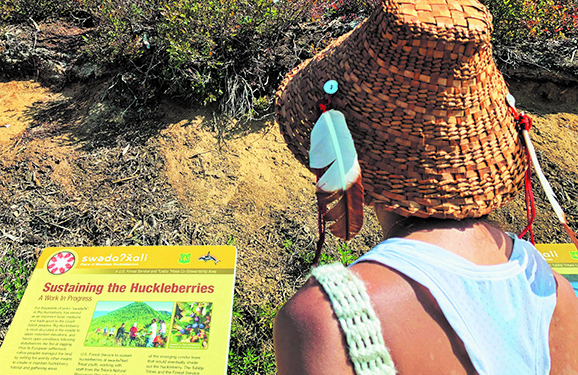
Service partnership.
By Micheal Rios, Tulalip News
For thousands of years, huckleberry has served as an important food, medicine, and trade good to the Coast Salish peoples. Mountain huckleberry is most abundant in the middle to upper mountain elevations, and favors open conditions following disturbances like fire or logging. Prior to European colonization, Native peoples managed ideal harvesting locations by using fire and other traditional means to maintain huckleberry growth for sustainable picking.
In 2011, the Tulalip Tribes began working cooperatively with the U.S. Forest Service to sustain huckleberries at a 1,280-acre parcel of land, 4,700 feet above elevation in the upper Skykomish River watershed. This particular location is one of several co-stewardship areas throughout the Mt. Baker-Snoqualmie National Forest where Tulalip collaborates with the Forest Service to preserve and maintain important cultural resources.
“The huckleberry co-stewardship work is one of the ways we are partnering with the Mt. Baker-Snoqualmie National Forest to help sustain huckleberries on the forest, and ensure that tribal members will continue to have the opportunity to gather important resources and practice traditions central to their culture,” said Tulalip Environmental Policy Analyst, Libby Nelson, back in 2016. “Treaty rights encompass more than an opportunity to pick berries, hunt game or harvest fish. Having a meaningful role on the ground, in the stewardship of these resources, helps reconnect tribal peoples to these lands and the teachings of their ancestors.”
Named swədaʔx̌ali, Lushootseed for ‘Place of Mountain Huckleberries’, this end of summer destination gives Tulalip tribal members an opportunity to walk in the steps of their ancestors and harvest the highly prized mountain huckleberry. The official announcement that the berry bounty at swədaʔx̌aliι was ripe and ready for picking came from our forestry program manager, Nick Johnson, on August 24.
“The huckleberries are ripe. The gate to swədaʔx̌ali now has a combination lock on it to enable tribal access. To get the combination of the lock please call the Admin Building front desk at 360-716-4160,” Nick’s announcement read. “After your party has gone through the gate please lock it behind you, so that any non-tribal groups don’t enter and potentially end up getting stuck behind a locked gate. The road has some deep-water bars where you’ll probably want a high-clearance vehicle to get through. Also the new gate is heavy and can take some effort to close and lock in place.”
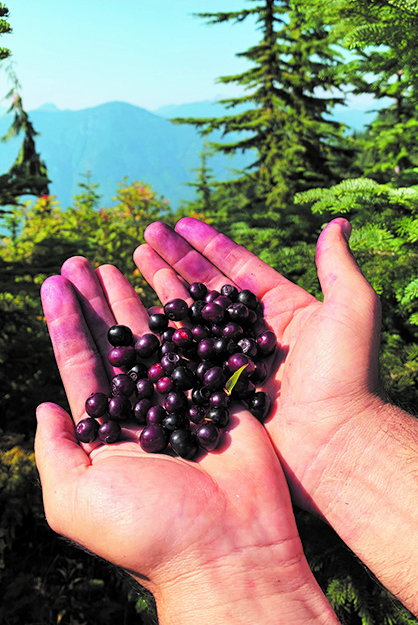
Northwest mountain huckleberries generally ripen in the late summer and can be picked into the early fall. Huckleberry, well-known for boosting the immune system and being rich in antioxidants, has always had a strong relationship to the area’s Indigenous cultures. Coast Salish tribes consider the huckleberry to be an important dietary staple because of its medicinal properties and sweet, delicious taste.
“Huckleberry is a food and medicine to our people,” explained Tulalip elder Inez Bill. “Our ancestors visited certain areas for gathering these berries. They knew where the berries were growing, what companion plants were growing there too, and how to use them.
“Through the teachings of how we value, take care of and utilize our environment, we pass down our history and traditions, and what is important to the cultural lifeways of our people,” she continued. “This connection to the land enables us to know who we are as a people. It is a remembrance. Today, it is not only important that we continue the struggle to uphold our treaty rights, but we need to be involved in taking care of those resources our culture depends on so they will be available to future generations.”
swədaʔx̌ali is a prime example of how Tulalip is diligently working to reclaim traditional areas. Stemming directly from the Point Elliot Treaty, which secured claims to gather roots and berries in all open and unclaimed land, the ‘Place of the Mountain Huckleberries” is clear expression of Tulalip’s sovereignty.
Embracing that sovereignty is every tribal member who journeys to this ancestral harvesting area and practices their cultural traditions that continue to be passed on from one generation to the next. The mountain huckleberry is intimately tied with traditional Tulalip lifeways and culture.
Historically providing an end of summer harvest opportunity, the journey to swədaʔx̌ali strengthens a deep connection to the land. Nearly 5,000 feet up, in the Mt. Baker-Snoqualmie National Forest, berry pickers are completely immersed in the grand splendor that is the Pacific Northwest. Epic views of luscious, green-filled forestry, towering mountains, and clear waterways can be mesmerizing.
“It was a beautiful, uplifting experience. Once we hit the forest, where there were no buildings, no cars, no people, just trees…my spirit soared,” shared annual huckleberry harvester Maria Rios. “I’m fortunate to have the opportunity to speak my language, but that is only a piece of my culture. Berry picking feels natural, like I’ve always done it. The smells are intoxicating. The sounds are beautiful, from the buzzing bugs and chirping birds to the gentle breeze rustling the huckleberry leaves. These are the meaningful experiences that we all need to share in.”
“Oh my god. What a great day in the mountains!” added first time swədaʔx̌ali visitor Lena Hammons, who ventured up the mountain cautiously with her companion Jamie Sheldon. “This was my first time out gathering since I was a little girl. Definitely my first time participating in the tribal harvest. It was awesome listening to the laughter, trying to fill my bucket with huckleberries and wild blueberries. Was fortunate to get some awesome devil’s club, too, which makes my truck smell amazing. We got to wash our faces in the river on the way down. The entire experience was so healing and filled my spirit with love. All our people need to experience the beauty of swədaʔx̌ali.”
Mountain huckleberry season is short, lasting only a few weeks between August and September. The sought after super food and medicine ranges in color from red to deep blue to maroon. They are similar to a blueberry in appearance and much sweeter than a cranberry, with many people rating huckleberries as the tastiest of the berry bunch. The gate to swədaʔx̌ali will only remain accessible to Tulalip membership for a few more weeks, so don’t miss the opportunity to harvest and take in breathtaking views, while expressing your inherent tribal sovereignty.
Huckleberry Health Benefits:
- Huckleberries are full of antioxidants, compounds that are essential for improving the health of numerous systems within the body, while also preventing the development of serious health issues.
- An excellent source of vitamin A and B, huckleberries are great for promoting a healthy metabolism which in turn helps reduce the risk of stroke. They are also known to help stave off macular degeneration as well as viruses and bacteria.
- Huckleberries are associated with lowering cholesterol; protecting against heart diseases, muscular degeneration, glaucoma, varicose veins, and ulcers.
- Huckleberries are an excellent source of iron which helps build new red blood cells and helps fatigue associated with iron deficiency.
- High in vitamin C, huckleberries protect the body against immune deficiencies, cardiovascular diseases, prenatal health problems, and eye diseases.
September 3, 2022 syəcəb
Please use the following link to download the September 3, 2022 issue of the syəcəb
Back 2 School Party sends students off to school in a good way
By Kalvin Valdillez, Tulalip News
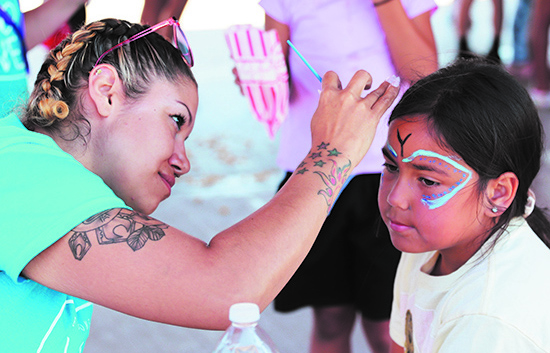
The Don Hatch Youth Center parking lot was shut down on the afternoon of August 24. At the center of the campus, surrounded by a dozen of smiling faces, a creature with white fur and a blue face happily danced to a feel-good set curated by local Mixmaster, DJ Monie.
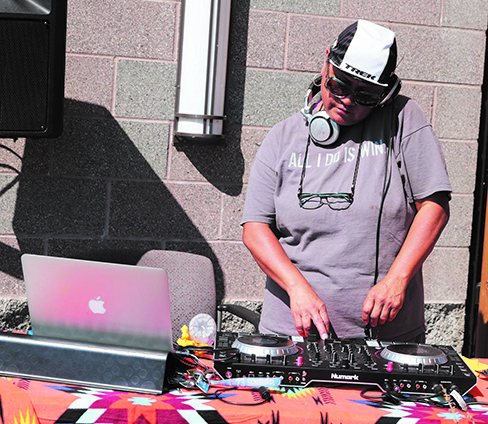
You may ask why in the world the mythical legend known as the Yeti, a.k.a. the Abominable Snowman, was getting its grove on in near 80-degree weather. And the answer, of course, is to celebrate the Tulalip Education Division’s annual Back 2 School Party.
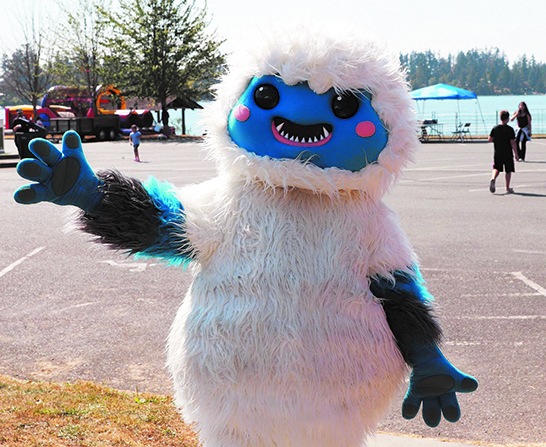
“I think today was awesome,” exclaimed young tribal member, Peyton Gobin. “I came down because I wanted to see my friends and my family. I’m going into the 7th grade. I’m excited and think the new school year will be really fun.”
The Yeti tagged along to the shindig with the Grove Street Church, whose membership volunteered to supervise the rides and attractions. In addition to the many volunteers, the church also donated two bouncy houses so the youth could get their jump on during the back-to-school bash.
To provide endless amounts of fun throughout the day, the Tulalip Education Division also enlisted the Reptile Girl, the Tulalip Police Department, the Tulalip Bay Fire Department, Paws With A Cause, Skate Like A Girl, Hatter Mike Balloon Twister, and QuakeHOLD!
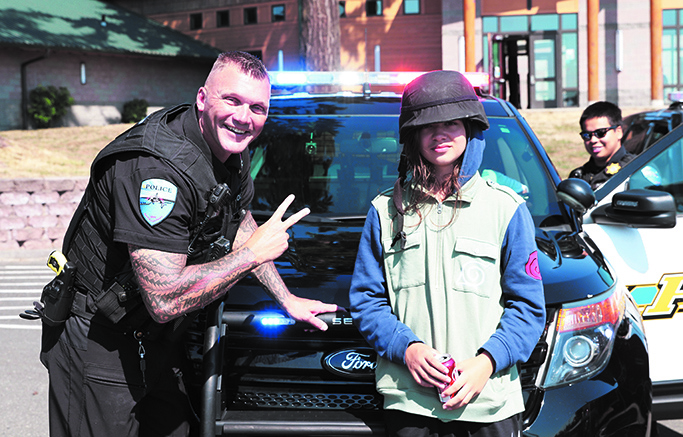
Youth of all ages had a blast during the five-hour event while they visited all of the activity booths, rides, and petting zoo animals including alpacas, turtles, and alligators.
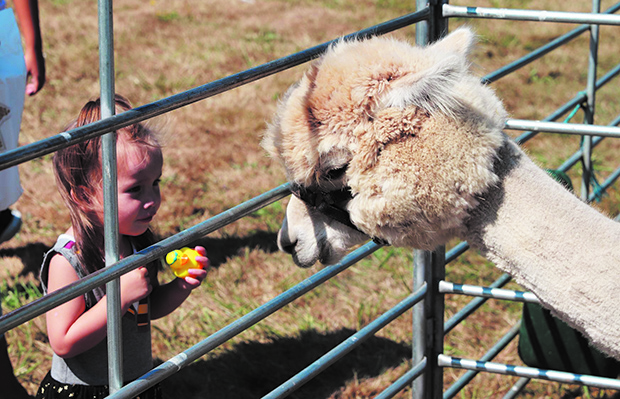
“I liked the lady with the whistles,” said Sophia Quimby. “Everyone’s been getting whistles from her, so I went up to her and she’s really nice. I got a whistle and also got a picture, and pencils from the fire department that I can take home. But my favorite part of the day was probably the pirate ship.”
Gia Joseph agreed, “Yes! The pirate ship was probably my favorite too. And I’m taking home a picture, a highlighter, and a coloring book.
“It’s a very exciting event,” Sophia added.
“It’s pretty much the best.” Gia concurred.
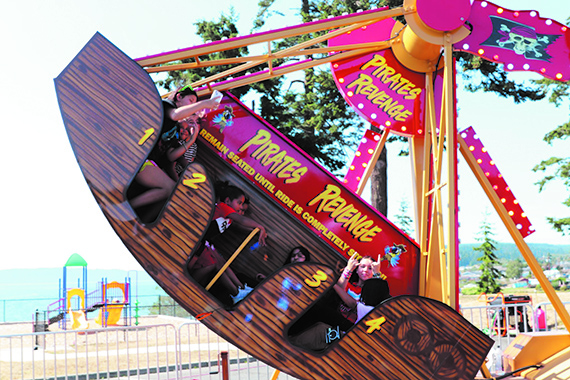
With painted faces and snow cones in hand, the kids of Tulalip met with their friends and relatives as they explored the youth campus, taking plenty of time to ride the Pirate’s Revenge carnival ride and joust against each other in a padded ring, American Gladiators style.
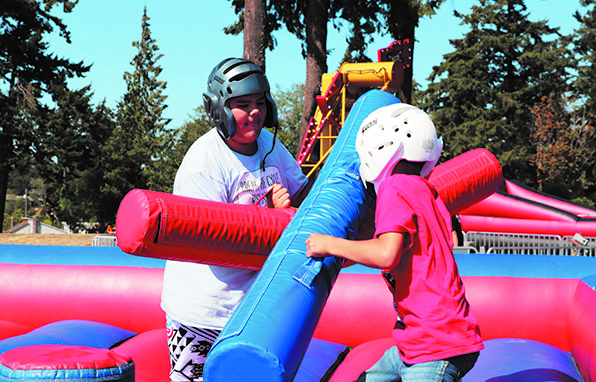
“Seeing all the interactions with the children, it’s the big start for the new school year,” said Tulalip BOD, Hazen Shopbell. “I like seeing them all having fun together. I think this is a wonderful event where everyone comes together to help support the kids. It’s a good way to prepare them for school, I try to make it every year with my children.”
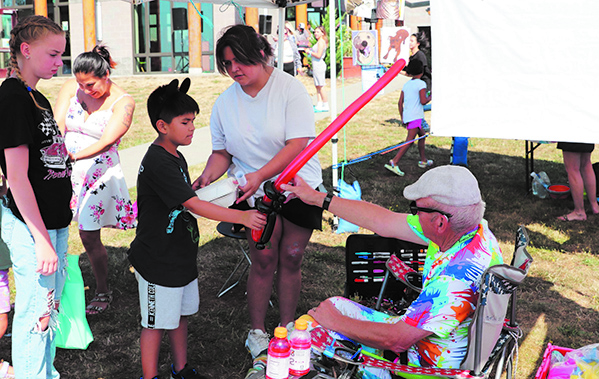
Inside the gymnasium were rows upon rows of information and resource booths. The idea of bringing-in departments such as Tulalip Higher Education, the Homework Support Club, and Family Resources, as well as Marysville School District (MSD) representatives including faculty from Heritage High, Quil Ceda Tulalip Elementary and the MSD Native American Liaisons, was for students and families to get acquainted with their teachers, counselors, and all those who they will be working with throughout the academic year.
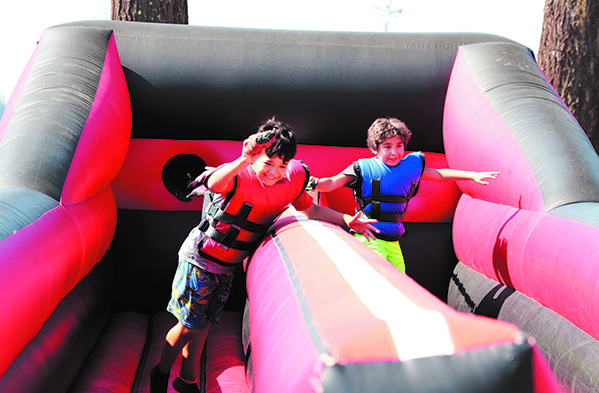
“It’s important to celebrate back to school because our children need to see our excitement for learning,” expressed Tulalip Education Division Director, Jessica Bustad. “We want to thank all the volunteers, staff, vendors, MSD employees, and the Positive Youth Development team for providing the excitement of going back to school. It was great seeing the kids visit with their teachers, youth workers, and other organizations that serve them. It’s important for us to set that example for the kids. We want our kids to know that education is a priority to us, and we support them 100%. It’s been a long summer, so seeing all the smiling faces in one place is a good feeling. It’s nice to see the staff engaging and reuniting with their students.”
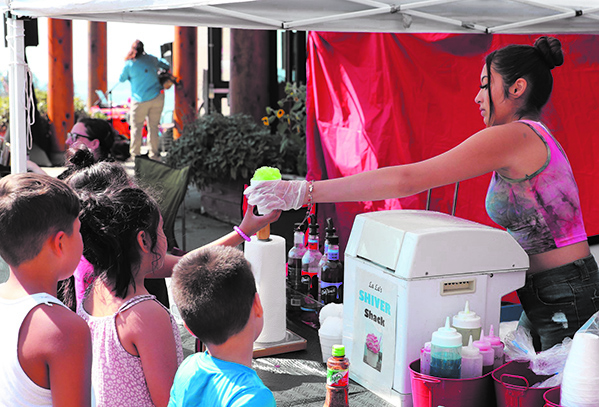
The Back 2 School Party was the perfect way to close out summer and celebrate new beginnings as the 2022-2023 school year quickly approaches.
“This event sends our kids back to school in a good way,” explained Tulalip Youth Advocate, Deyamonta Diaz. “It’s fun for the families to hang out, no stress, and meet with staff from their schools without the pressure of the school setting. We provide food so the families get to eat some good food and just enjoy the end of the summer before gearing up to get ready for school.”
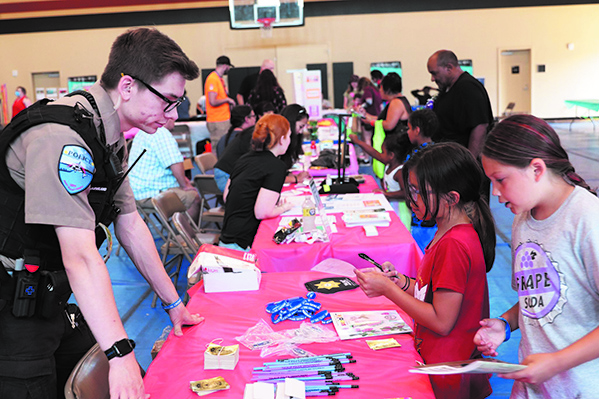
Good luck to all the young scholars as they begin their new academic year!
